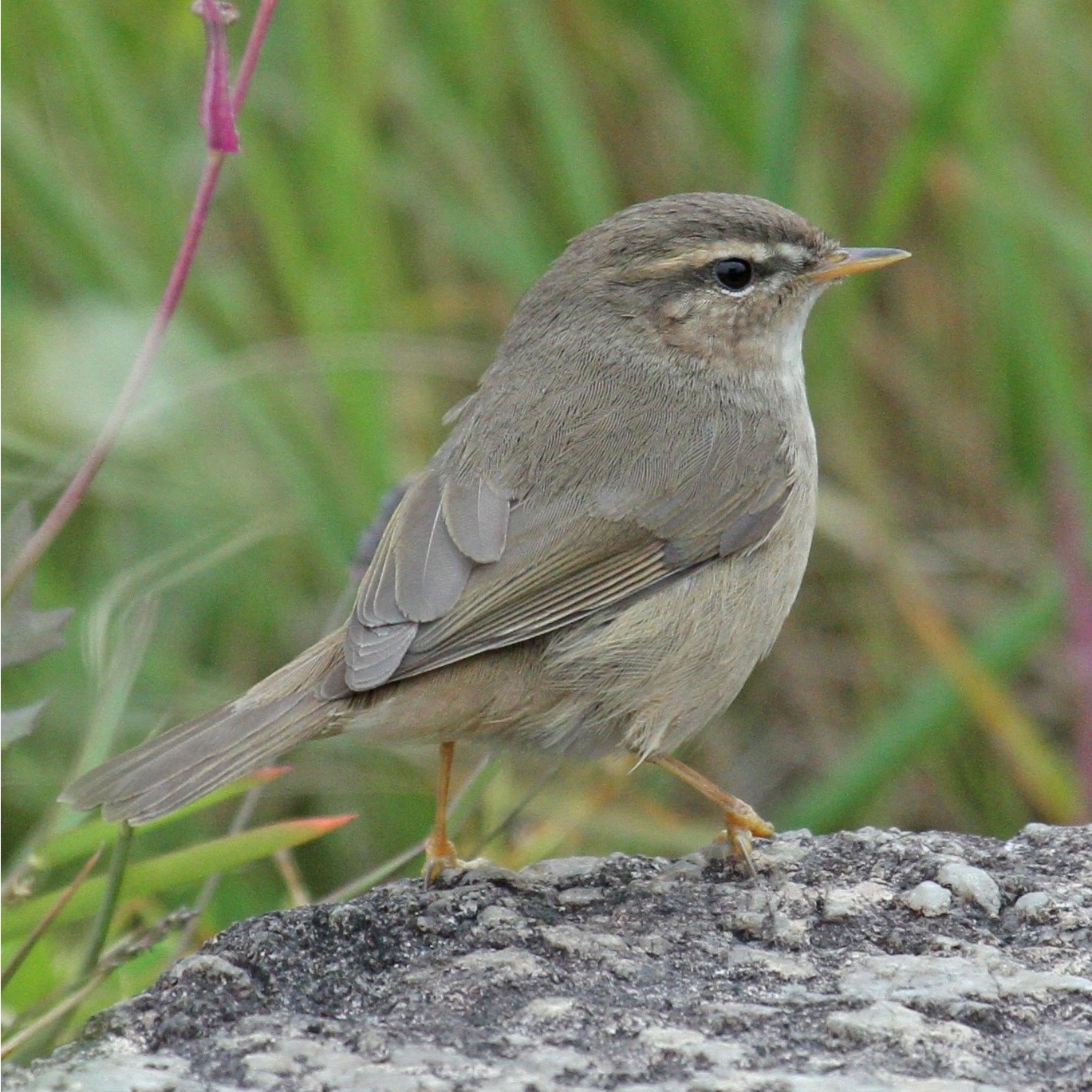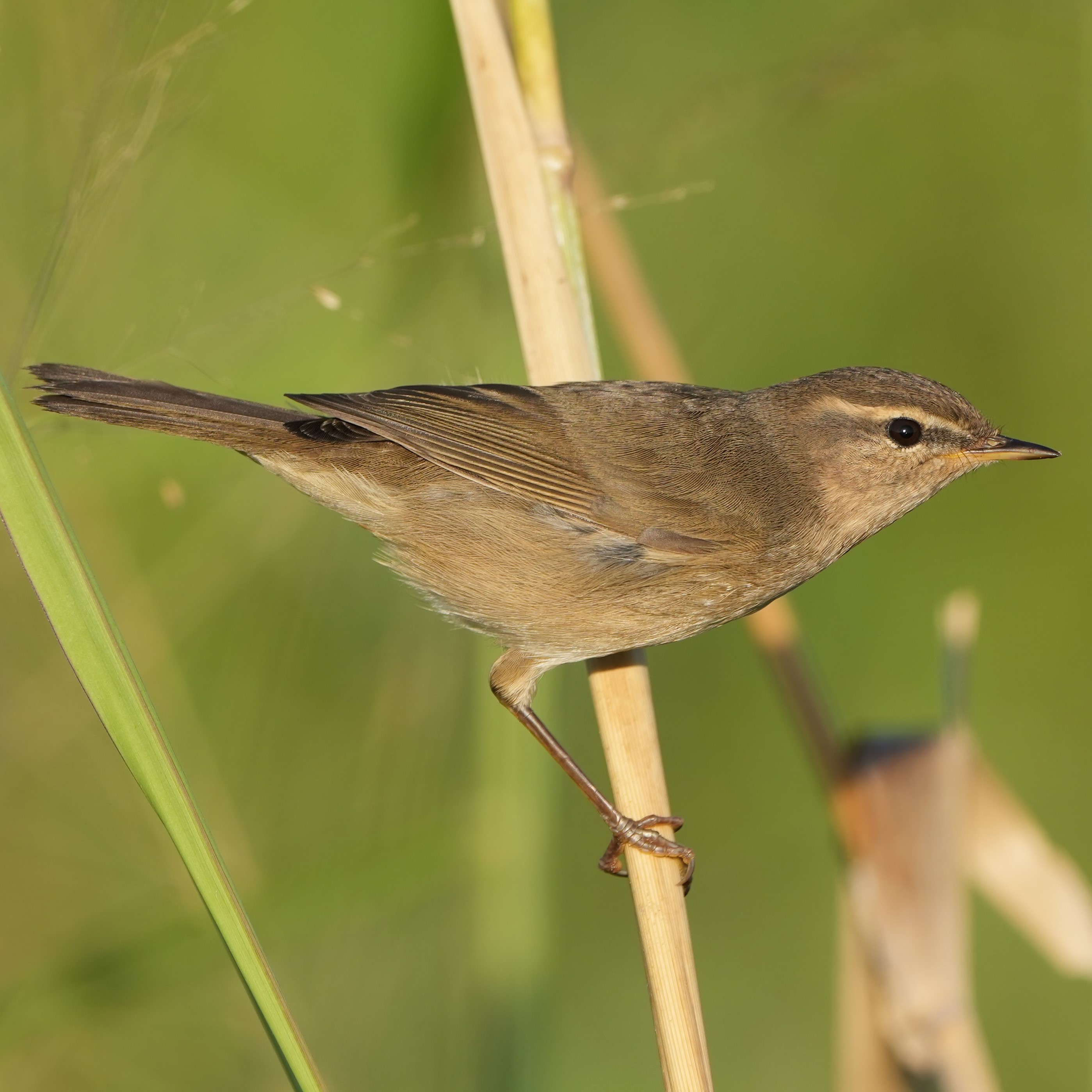Dusky Warbler Phylloscopus fuscatus 褐柳鶯
Category I. Common passage migrant and winter visitor to open country areas with shrubs.
IDENTIFICATION

Dec. 2009, CHUNG Wing Kin.
11-12 cm. The commonest Phylloscopus warbler in open-country habitats for much of the winter period. Plain grey-brown upperparts and wing coverts, whitish underparts with faint buff wash on flanks and undertail coverts, whitish supercilium and dark eye stripe, both more distinct in front of the eye. The thin legs and much of lower mandible both have an orange tone.

Nov. 2023, Paul Leader.
This more typical pose captures the character and structure of Dusky Warbler, including the thin legs, unremarkable bill, plain upperparts and more distinct eye stripe in front of the eye. The effect of strong sunlight on colour tone can also be appreciated.
VOCALISATIONS
The call is a hard ‘tak’, similar to the sound of two pebbles being struck together.
Low-intensity song can be heard in spring, mainly from the last week of March to the end of passage.
DISTRIBUTION & HABITAT PREFERENCE
Although recorded from widespread areas, it shows a preference for vegetation close to damp areas; it is most common in the Deep Bay area and distinctly rare in shrubland and woodland edge habitat. Away from Deep Bay it is most frequently recorded in autumn and is rather scarce in winter. Records in late spring, including singing males, are most often from the northwest New Territories.
The percentage of 1km squares in which it was present increased from 21.5% to 24.3% between the 2001-05 and 2016-19 winter atlas surveys. The core wintering distribution was the same, from Deep Bay to the northeast New Territories and, to a lesser extent, lowland areas of Lantau and Sai Kung.
OCCURRENCE
The most systematic dataset available for this species comes from the constant-effort trapping programme in the reedbed at Mai Po between the winter periods of 2008/09 and 2020/21 (Figure 1). From the first bird trapped during the second week of September, numbers increase steadily to a distinct peak in the first week of November and then decline equally sharply to the second week of December, followed by a long-term and irregular decline to the end of spring passage. There is a suggestion of spring passage, but it is very weak. The autumn peak is later than the second half of October peak apparent in trapping data collected at the same site from 1975 to 1997 (though this was not constant-effort and included habitats other than reed marsh).
The pattern of records at all sites across HK is similar in terms of the relative strength of autumn passage but the subsequent decline is much more gradual and consistent to the end of spring, indicating the preferred wintering habitat is not reed marsh (Figure 2).
The earliest on record occurred on 6 September at Mai Po in 1964 and Sai Kung in 2016, and the latest occurred on 25 May 2011 at Mai Po. The highest counts are all from Mai Po: 157 trapped on 27 October 2017 and 100 present on 4 November 1984 and 14 October 2015.
Recorded by Swinhoe (1861) and noted as a common winter visitor and passage migrant by Herklots (1953), who also stated that it is often found in the vicinity of water.
BEHAVIOUR, FORAGING & DIET
A restless species, but also rather skulking meaning many birds are not easy to see well. Forages in shrubs and low vegetation on insects. Melville (1988) described an instance of polyrectricyly in this species.
RANGE & SYSTEMATICS
Two subspecies are recognised. Then nominate breeds from central and east Siberia east to the Sea of Okhotsk and Kamchatka, including northeast China and north Mongolia, while P. f. robustus breeds to the south in north central China. Winters from the Himalayas east through Indochina to south and east China as far north as Beijing where it is rare (Clement 2020, Liu and Chen 2020, Birding Beijing 2022).
CONSERVATION STATUS
IUCN: Least Concern. Population trend stable.
Figure 1.

Figure 2.

Birding Beijing (2022). https://birdingbeijing.com/the-status-of-the-birds-of-beijing/ (Accessed 26 September 2022).
Clement, P. (2020). Dusky Warbler (Phylloscopus fuscatus), version 1.0. In Birds of the World (J. del Hoyo, A. Elliott, J. Sargatal, D. A. Christie, and E. de Juana, Editors). Cornell Lab of Ornithology, Ithaca, NY, USA. https://doi.org/10.2173/bow.duswar.01
Herklots, G. A. C. (1953). Hong Kong Birds. South China Morning Post, Hong Kong.
Liu, Y. and Chen, Y. H. (eds) (2020). The CNG Field Guide to the Birds of China (in Chinese). Hunan Science and Technology Publication House, Changsha.
Melville, D. S. (1988). Polyrectricyly in a Dusky Warbler. Hong Kong Bird Report 1987: 105-106.
Swinhoe, R. (1861). Notes on the ornithology of Hong Kong, Macao and Canton, made during the latter end of February, March, April and the beginning of May 1860. Ibis 1861: 23-57.

